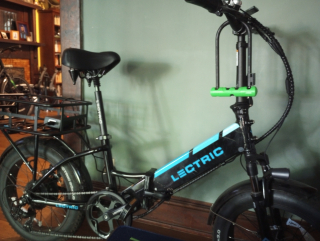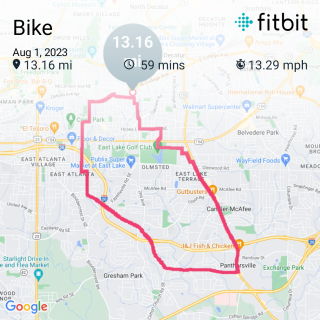
The answer is an e-bike.
I have been using an e-bike we bought for my son’s commute for several months now. The e-bike I chose is the Lectric XP 3. It cost $1,000, amazing because my old road bike cost me $800 in 1981.
The Lectric is foldable. It’s too heavy for a bike rack, but it breaks at the base and the handlebars so you can get it into the trunk of a Toyota Corolla. The battery is in the down tube. You plug it into the wall. (Unplug it as soon as the light goes green.) Top speed is 20, with pedal assist, but the weight lets it run down Atlanta’s hills at 25-30. Range is estimated at 20 miles but the way I ride, which is carefully, it’s closer to 30.

Now, about living in traffic. Atlanta is one of the worst cities in America for bicycling. Georgia is notoriously anti-bike. The city government isn’t much better, relying on a bike advocacy group called PATH that sees bikes as healthy recreation, not a way to get around.
Inside the pre-World War II footprint of the city, the Lectric is great. Roads have just two lanes. Parking slows cars down even more. I can get to a store in minutes using the lower gears at 10 mph. An e-bike is much better than a road bike on things like the Beltline, which are filled with kids and adults who have their eyes on phones. You’re comfortable and can stop.
It’s when you get outside this bubble that you have trouble. Land is split into parcels as much a half-mile to the side. Travel is on wide roads built for cars and there may be no designated bike lanes. Here, I use the higher gears, which let me run at 20 mph and higher, charging the battery on the downhills. You’re depending on drivers not running you over from behind, but I’ve been doing that since 1978 and it has yet to happen. If an accident is going to happen it will be right in front of me, someone opening a car door or veering to make a right turn. (I did this route the other day. Lots of hills. Couldn't make it on my old road bike. On the Lectric, it took less than an hour and used less than half the battery.)
What will change life for e-bikes is scaling. If only 2% of us are on an e-bike, cities will remain car centric. Wherever the riding population gets into double digits, you start to see accommodations. I’m talking about protected bike lanes and laws against car encroachment. The Beltline is a start to making that happen.
This is the chicken-and-egg quandary of the e-bike rider. We’re still in the early adopter stage. But the mass market is made deliberately fearful by car lobbyists, governments, and dangerous drivers. I’m hoping to bike another decade or maybe two, thanks to e-bikes. I’d like it to be on safe roads.










